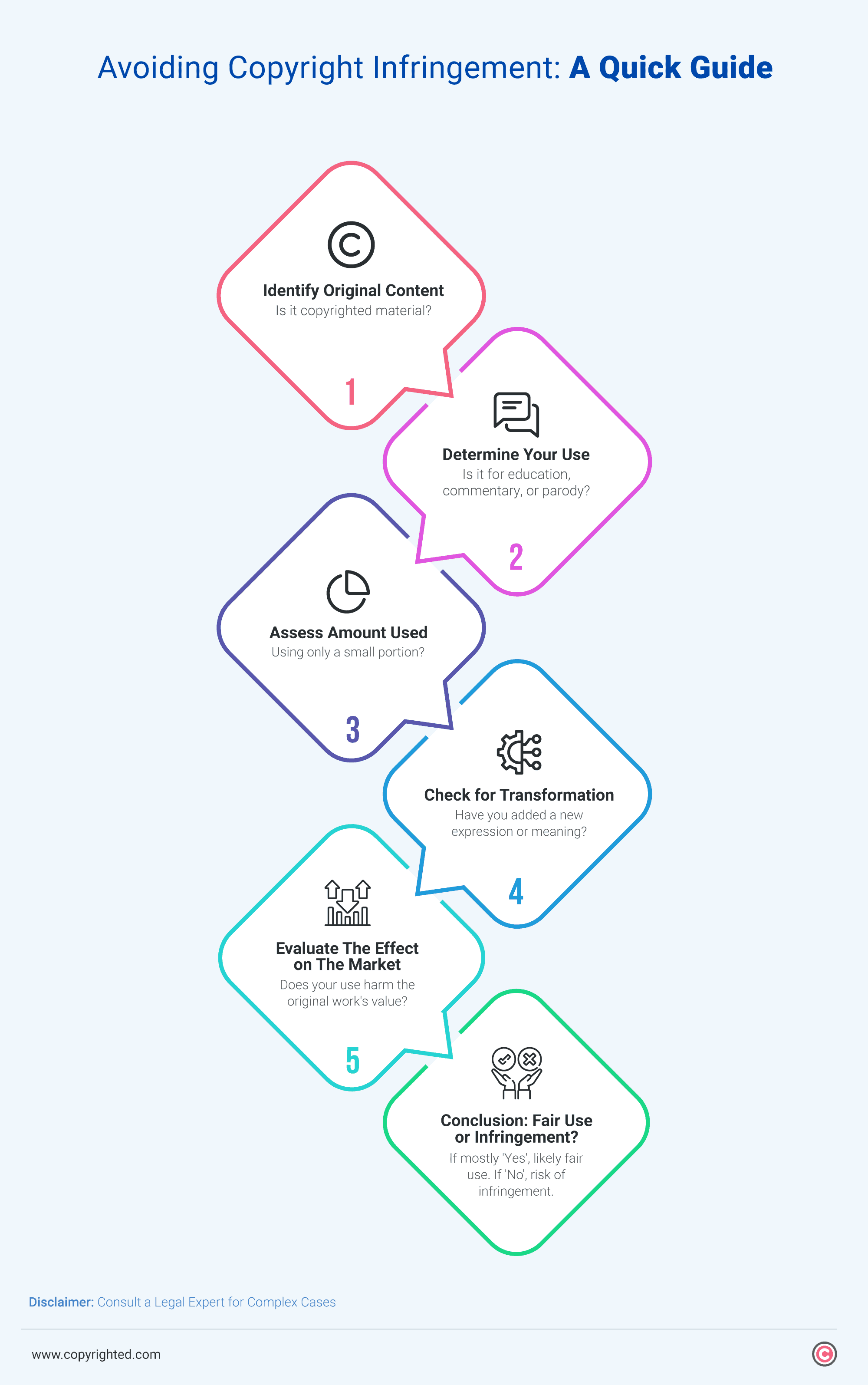You might have heard a common saying online that if you change 30 percent of a copyrighted work, it’s no longer considered infringement, and you’re free to use it.
Well, that rule is but an internet myth.
The truth is that figuring out if something is too similar depends on different legal tests used by various courts. The key factor is how much the two works look alike in context.
And here’s the kicker, this decision can also vary depending on the type of content you’re dealing with. It’s not as straightforward as the 30 percent rule suggests.
In reality, understanding copyright in the digital realm goes beyond knowing the rules, it requires a mix of creativity, ethics, and legal awareness.
As for content publishers seeking originality, the question arises: If not 30%, then what is the percentage of copyright exemption necessary to avoid infringement?
In this guide, we’ll be uncovering the importance of transformative changes and the balance between creativity and rules.
We’ll cover copyright specifics for different content types, discover ways to avoid legal issues, and promote respect in the creative community. Whether transforming text, handling copyright photos, or navigating the music domain, each aspect contributes to ethical content creation.
Now, let’s simplify the essentials of copyright in the digital age.
- Whether it’s text, images, or music, focus on transformative changes to avoid copyright issues.
- Always attribute and seek permission when using someone else’s original work, it’s not just a legal requirement but also an ethical practice.
- Take a moment to review your content before publishing and ensure it aligns with copyright laws and respects the rights of original creators.
How Much Do You Need to Change to Avoid Copyright Infringement?

To avoid copyright infringement, you need to make substantial changes to the original work. The key here is transformation, ensuring that the content becomes distinctly yours by altering its structure, language, and overall expression.
As we discuss how much change is necessary to avoid infringement, it’s also essential to grasp the basic concepts of transformative creation and fair use.
Now, fair use is a legal concept that allows limited use of copyrighted material without permission from the copyright holder.
While the idea of fair use may seem like a promising option, it’s important to tread carefully and, most importantly, understand the complexities of this concept.
Relying solely on fair use can sometimes be a gray area, and the interpretation of what qualifies can vary.
To ensure a safer and more secure creative journey, it’s wise to lean towards transformative changes especially when working with visual content. While fair use provides some flexibility, transformative changes not only minimize the risk of copyright concerns but also offer a clearer path to showcasing your unique artistic vision.
Understanding this also brings up a key question many creators ask: Can you change copyrighted material and still stay on the right side of the law? The answer depends on how significantly you transform the work and how clearly it differs from the original source.
Now, let’s break down the specifics of how much you need to change to avoid copyright infringement across different content types:
Text
Now you might be thinking, is it still protected by copyright if you change the words?
It’s important to go beyond simple changes like paraphrasing or minor tweaks when dealing with existing written content. To avoid copyright issues, aim for more significant alterations and changes that truly make the content your own.
This transformation serves two purposes. First, it helps prevent copyright problems by making your work stand out from the original. Second, it’s a chance to showcase your creativity and individuality as a content creator.
Making substantial changes isn’t just about following the rules, it’s an opportunity to let your innovation and unique perspective shine.
When you’re working with text and wondering how much change to avoid copyright infringement, remember to add significant changes to the original work to make the content unmistakably yours. Use this chance to tell your story and let your creative voice come through in your writing.
Images and Visual Works
When it comes to dealing with images and visual content, the principle at the forefront is still transformation.
Simply editing copyright photos with surface-level changes or cosmetic alterations might not be sufficient to build a strong defense against potential copyright issues. Instead, go beyond surface-level adjustments.
Strive for a modification that goes above and beyond the original, offering a new and unique perspective. By making these significant changes, you not only reduce the risk of copyright issues but also get the chance to showcase your artistic vision.
Music and Sound
When working with music and sound, using a snippet of the melody, known as “sampling,” is tempting. However, it’s important to be careful because even a small part can have copyright protection.
Sampling involves taking a segment of an existing musical work and incorporating it into a new composition. While this artistic practice can add depth and familiarity to your creations, it also brings a set of legal considerations.
If you’re not creating your own music, be careful when adding existing music to your work. Some safe alternatives include seeking out music that is either royalty-free or appropriately licensed.
This not only shields you from potential legal issues but also aligns with the principles of fair compensation for fellow artists.
General
In general, it’s important to be mindful of copyright rules when using the internet.
Always give credit when using someone else’s work in your creations. This means clearly stating where you got the content from and respecting the original creator’s rights.
Remember, giving credit is not just a rule but also a way to show respect in the creative community.
If you’re unsure about whether you can use something you find online, it’s smart to ask for permission. Don’t assume everything is free to use – it often isn’t.
Taking a moment to check ensures you follow copyright laws and keep your creative work intact.
Think about the saying, ‘An ounce of prevention is worth a pound of cure.’ This is especially true for copyright.
Before sharing your work online, take a moment to review it. Make sure it fits your vision and follows the rules for intellectual property.
Being proactive in following these rules isn’t just about avoiding legal problems. It’s a way to respect other creators and contribute to a digital world where everyone appreciates each other’s efforts.
Also, understanding what does subject to copyright mean helps clarify which works are protected and how you can approach using them creatively and legally.
To sum it up, as you explore the internet, remember that following these guidelines isn’t just a rule – it shows your commitment to creating content ethically. Give credit, ask for permission when needed, and make sure your work aligns with copyright laws before sharing it with others.
Frequently Asked Questions
Is it copyright if you change the words in a text?
It can be, as changing words alone may not be sufficient. Aim for substantial alterations to make the content uniquely yours.
Can you use any music if you’re not creating my own?
No, it’s advisable to use royalty-free or licensed music to avoid legal complexities and support fair compensation for artists.
Are minor changes enough to avoid copyright issues?
No, aim for significant changes that go beyond superficial adjustments to make your work distinct.
Is it legal to use content from the public domain?
Yes, content in the public domain is free to use without copyright restrictions.
What is fair use, and can you rely on it completely?
Fair use allows limited use for specific purposes, but its application can be subjective. It’s safer to complement it with transformative changes.
Can you avoid copyright issues by giving credit to the original creator?
Giving credit is important, but it’s not always enough. Seek permission from the copyright owner for added assurance.


